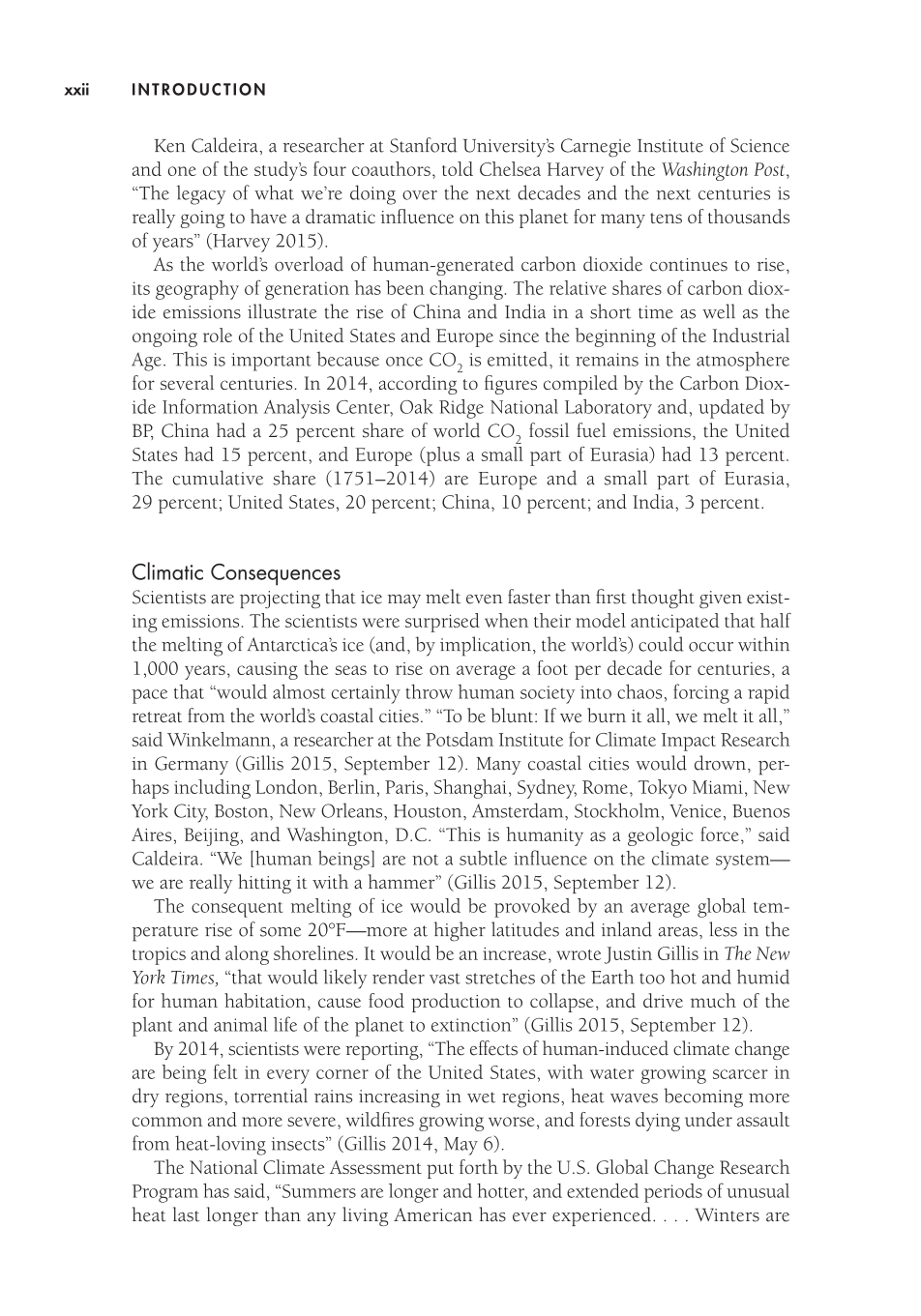Introduction xxii
Ken Caldeira, a researcher at Stanford University’s Carnegie Institute of Science
and one of the study’s four coauthors, told Chelsea Harvey of the Washington Post,
“The legacy of what we’re doing over the next decades and the next centuries is
really going to have a dramatic influence on this planet for many tens of thousands
of years” (Harvey 2015).
As the world’s overload of human-generated carbon dioxide continues to rise,
its geography of generation has been changing. The relative shares of carbon diox-
ide emissions illustrate the rise of China and India in a short time as well as the
ongoing role of the United States and Europe since the beginning of the Industrial
Age. This is important because once CO2 is emitted, it remains in the atmosphere
for several centuries. In 2014, according to figures compiled by the Carbon Diox-
ide Information Analysis Center, Oak Ridge National Laboratory and, updated by
BP, China had a 25 percent share of world CO2 fossil fuel emissions, the United
States had 15 percent, and Europe (plus a small part of Eurasia) had 13 percent.
The cumulative share (1751–2014) are Europe and a small part of Eurasia,
29 percent; United States, 20 percent; China, 10 percent; and India, 3 percent.
Climatic Consequences
Scientists are projecting that ice may melt even faster than first thought given exist-
ing emissions. The scientists were surprised when their model anticipated that half
the melting of Antarctica’s ice (and, by implication, the world’s) could occur within
1,000 years, causing the seas to rise on average a foot per decade for centuries, a
pace that “would almost certainly throw human society into chaos, forcing a rapid
retreat from the world’s coastal cities.” “To be blunt: If we burn it all, we melt it all,”
said Winkelmann, a researcher at the Potsdam Institute for Climate Impact Research
in Germany (Gillis 2015, September 12). Many coastal cities would drown, per-
haps including London, Berlin, Paris, Shanghai, Sydney, Rome, Tokyo Miami, New
York City, Boston, New Orleans, Houston, Amsterdam, Stockholm, Venice, Buenos
Aires, Beijing, and Washington, D.C. “This is humanity as a geologic force,” said
Caldeira. “We [human beings] are not a subtle influence on the climate system—
we are really hitting it with a hammer” (Gillis 2015, September 12).
The consequent melting of ice would be provoked by an average global tem-
perature rise of some 20°F—more at higher latitudes and inland areas, less in the
tropics and along shorelines. It would be an increase, wrote Justin Gillis in The New
York Times, “that would likely render vast stretches of the Earth too hot and humid
for human habitation, cause food production to collapse, and drive much of the
plant and animal life of the planet to extinction” (Gillis 2015, September 12).
By 2014, scientists were reporting, “The effects of human-induced climate change
are being felt in every corner of the United States, with water growing scarcer in
dry regions, torrential rains increasing in wet regions, heat waves becoming more
common and more severe, wildfires growing worse, and forests dying under assault
from heat-loving insects” (Gillis 2014, May 6).
The National Climate Assessment put forth by the U.S. Global Change Research
Program has said, “Summers are longer and hotter, and extended periods of unusual
heat last longer than any living American has ever experienced. . . . Winters are

























































































































































































































































































































































































































































































































































































































































































































































































































































































































































































































































































































































































